The daily backpacks market is valued at USD 33,218.3 million in 2025 and is expected to reach USD 56,206.1 million by 2035, with a rolling CAGR of 5.4%. From 2021 to 2025, the market grows consistently, moving from USD 25,537.3 million in 2021 to USD 33,218.3 million in 2025. During this period, annual growth increments reflect a steady upward trajectory, with the market reaching USD 26,916.3 million in 2022, USD 28,369.8 million in 2023, USD 29,901.7 million in 2024, and USD 31,516.4 million in 2025. The growth is driven by rising consumer demand for fashion-forward, durable, and multi-functional backpacks for daily use in urban environments, along with increased online shopping and e-commerce penetration.
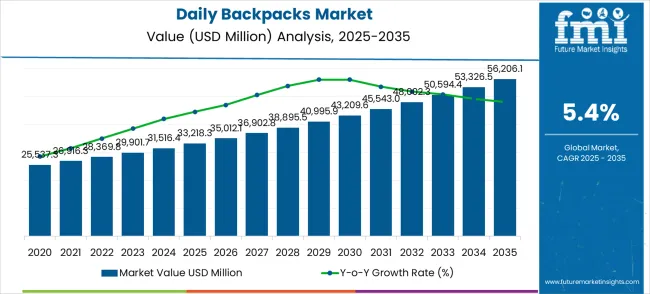
From 2026 to 2030, the market continues its positive growth trajectory, advancing from USD 33,218.3 million in 2025 to USD 43,209.6 million in 2030. The market moves through intermediate values of USD 35,012.1 million, USD 36,902.8 million, and USD 38,895.5 million, reflecting increased consumer preferences for customized, eco-friendly, and tech-integrated backpacks. In this phase, the demand for backpacks designed with specific functions, such as ergonomic support and rises sharply. Between 2031 and 2035, the market is expected to reach USD 56,206.1 million, driven by technological advancements, shifting consumer preferences, and the greater adoption of backpacks designed for convenience and lifestyle alignment, ensuring continuous rolling CAGR growth across the forecast period.
| Metric | Value |
|---|---|
| Estimated Value in (2025E) | USD 33,218.3 million |
| Forecast Value in (2035F) | USD 56,206.1 million |
| Forecast CAGR (2025 to 2035) | 5.4% |
The fashion and apparel market is the largest contributor, accounting for around 30–35%, as daily backpacks are considered an essential accessory for daily use, blending both style and functionality. The travel and tourism market follows closely with a contribution of approximately 20–25%, as backpacks are widely used for short trips, commuting, and outdoor activities, making them a staple item for travelers. The e-commerce market plays a significant role, contributing about 15–18%, as the growing trend of online shopping has made it easier for consumers to purchase backpacks from a wide range of brands and styles, often with added customization options. The sports and outdoor market accounts for around 10–12%, as backpacks designed for hiking, trekking, and sports activities drive demand for specialized features such as water resistance and durability. The technology accessories market accounts for approximately 8–10%, as many daily backpacks now come equipped with compartments for laptops, tablets, and other electronics, making them essential for tech-savvy consumers.
Market expansion is being supported by the increasing global demand for versatile everyday carry solutions and the corresponding need for functional bags that can accommodate diverse daily activities while providing superior comfort and organizational capabilities across work, education, and leisure applications. Modern consumers are increasingly focused on implementing carry solutions that can support multiple lifestyle needs, enhance daily efficiency, and provide consistent performance across various environments and activity types. Daily backpacks' proven ability to deliver superior ergonomic design, comprehensive organization features, and versatile functionality make them essential accessories for contemporary urban lifestyles and active living solutions.
The growing emphasis on outdoor recreation and fitness activities is driving demand for daily backpacks that can support active lifestyles, provide weather resistance, and enable seamless transitions between indoor and outdoor environments. Consumer preference for products that combine professional appearance with recreational functionality is creating opportunities for innovative daily backpack implementations. The rising influence of remote work trends and digital nomad culture is also contributing to increased adoption of backpacks that can provide mobile office capabilities without compromising comfort or organizational efficiency during extended daily use.
The daily backpacks market represents a compelling lifestyle consumer goods opportunity driven by evolving work patterns, increased outdoor recreation participation, and the growing demand for versatile everyday carry solutions. As consumers worldwide seek functional accessories that seamlessly transition between professional environments, urban commuting, and recreational activities, daily backpacks are evolving from basic carrying solutions to sophisticated, multi-functional lifestyle tools that reflect personal values and activity requirements.
The convergence of hybrid work culture adoption, outdoor lifestyle trends, and eco-conscious consumption preferences creates demand drivers across multiple consumer segments. The market's strong growth trajectory from USD 33,218.3 million in 2025 to USD 56,206.1 million by 2035 at a 5.4% CAGR reflects fundamental shifts in how consumers approach daily organization, mobility, and lifestyle expression.
Geographic expansion opportunities are particularly pronounced in Asia-Pacific markets, where China (7.3% CAGR) and India (6.8% CAGR) lead through expanding middle-class consumption, urbanization trends, and growing outdoor recreation participation. The dominance of medium-capacity backpacks (15-35 liters at 55.0% market share) and male consumers (52.0% share) provides clear strategic focus areas, while emerging eco-friendly materials adoption and smart technology integration present new premium positioning opportunities across diverse lifestyle segments and geographic markets.
Rapid consumer market growth across China (7.3% CAGR) and India (6.8% CAGR) creates substantial expansion opportunities through localized product development, e-commerce platform integration, and urban lifestyle positioning. Expanding middle-class purchasing power, urbanization trends, and growing outdoor recreation participation drive demand for versatile daily carry solutions. Market entry strategies focusing on value positioning, local distribution partnerships, online-first strategies, and culturally-relevant designs unlock penetration in high-growth consumer markets while building scale for premium product development and brand establishment across emerging lifestyle segments. Expected revenue pool: USD 4.2-6.8 billion
Strengthening the dominant 15-35 liter segment (55.0% market share) through enhanced organizational systems, urban-professional aesthetics, laptop compatibility, and seamless indoor-outdoor functionality, addressing hybrid work patterns and urban commuting requirements. This pathway focuses on optimal storage-to-portability ratios, professional appearance standards, tech device integration, and comprehensive daily organization features. Market leadership consolidation through superior ergonomic design, premium materials, and comprehensive lifestyle integration enables premium positioning while defending competitive advantages against both smaller and larger capacity alternatives across diverse professional and lifestyle applications. Expected revenue pool: USD 3.8-5.9 billion
Pathway C - Eco-Friendly Materials Innovation & Conscious Positioning Development of environmentally superior backpack solutions featuring recycled materials, carbon-neutral production processes, circular design principles, and comprehensive eco-credentials addressing growing eco-conscious consumer preferences. This pathway includes bio-based materials, zero-waste manufacturing, product lifecycle extension, and extensive environmental transparency. Premium eco-positioning provides access to green-focused consumer segments, ecological certification programs, and corporate responsibility partnerships, while creating differentiation through authentic environmental stewardship and long-term brand value alignment with evolving consumer values. Expected revenue pool: USD 2.8-4.5 billion
Integration of intelligent features, including device charging capabilities, GPS tracking systems, anti-theft security features, and IoT connectivity, is transforming traditional backpacks into connected lifestyle accessories. This pathway addresses digital nomad requirements, urban security concerns, device management needs, and comprehensive connectivity solutions. Technology differentiation through proprietary smart features, app ecosystem development, and integrated lifestyle management creates premium positioning opportunities while enabling subscription-based services and ongoing customer engagement through connected product experiences and comprehensive digital lifestyle support. Expected revenue pool: USD 2.2-3.8 billion
Expansion within the dominant men's segment (52.0% market share) through masculine design aesthetics, professional appearance standards, outdoor-urban versatility, and comprehensive lifestyle functionality addressing male consumer preferences for practical, durable, and versatile carry solutions. This pathway encompasses business-casual compatibility, outdoor activity integration, minimalist design principles, and comprehensive daily organization systems. Premium positioning reflects superior durability, masculine aesthetic appeal, and comprehensive lifestyle integration that supports professional productivity and recreational pursuits while creating opportunities for lifestyle brand partnerships and comprehensive men's accessory ecosystem development. Expected revenue pool: USD 2.0-3.4 billion
Development of ultra-premium backpack solutions featuring modular design systems, personalization options, luxury materials, and comprehensive customization capabilities targeting affluent consumers seeking distinctive, high-quality carry solutions. This pathway encompasses made-to-order services, premium material selections, personalized features, and exclusive design collaborations. Ultra-premium positioning enables significant margin expansion while creating opportunities for luxury brand partnerships, exclusive retail relationships, and comprehensive lifestyle services that extend beyond individual products to encompass personalized lifestyle consultation and ongoing premium customer relationships. Expected revenue pool: USD 1.6-2.8 billion
Strategic expansion into the women's segment (48.0% market share) through feminine design aesthetics, fashion-forward styling, lifestyle-specific functionality, and comprehensive style integration addressing evolving female consumer preferences for backpacks that combine practical functionality with fashion appeal. This pathway encompasses professional women's requirements, active lifestyle integration, aesthetic versatility, and comprehensive style compatibility. Premium positioning through superior design integration, lifestyle versatility, and fashion-forward functionality creates opportunities for fashion industry partnerships, influencer collaborations, and comprehensive women's lifestyle brand development across diverse professional and recreational applications. Expected revenue pool: USD 1.5-2.6 billion
The market is segmented by capacity, application, and region. By capacity, the market is divided into 15-35 liters capacity, 36-60 liters capacity, and above 60 liters capacity. Based on the application, the market is categorized into men and women. Regionally, the market is divided into North America, Europe, Asia Pacific, Latin America, and the Middle East & Africa.
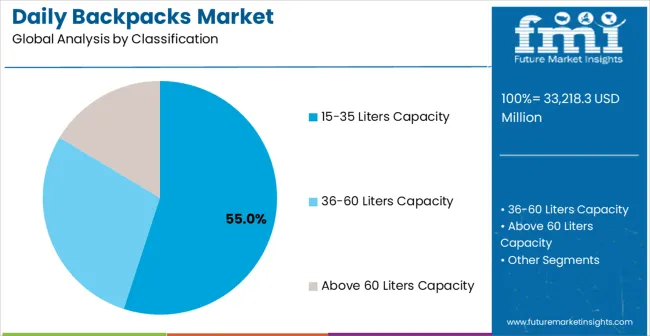
The 15-35 liter capacity segment is projected to account for 55.0% of the daily backpacks market in 2025, reaffirming its position as the leading capacity category. Consumers increasingly utilize medium-capacity backpacks for their optimal balance of storage space and portability, convenient daily carry capabilities, and versatility in urban commuting, office work, day trips, and educational applications. Medium-capacity daily backpack technology's advanced organizational features and comfortable carrying systems directly address the consumer requirements for practical everyday use and versatile functionality across diverse daily activities.
This capacity segment forms the foundation of modern everyday carry solutions, as it represents the size category with the greatest versatility and established consumer preference across multiple lifestyle categories and daily applications. Consumer investments in quality everyday carry gear and lifestyle optimization continue to strengthen adoption among urban professionals and active individuals. With consumers prioritizing practical storage capacity and comfortable daily use, medium-capacity daily backpacks align with both functionality objectives and lifestyle convenience preferences, making them the central component of comprehensive daily carry strategies.
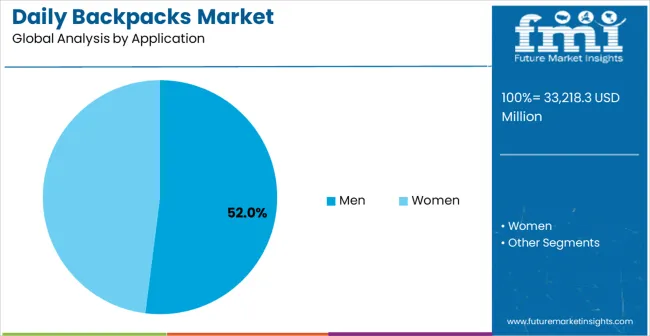
Men's applications are projected to represent 52.0% of daily backpack demand in 2025, underscoring their critical role as the primary consumers of functional backpack solutions for professional, educational, and recreational daily carry requirements. Male consumers prefer backpacks for their practical functionality, organizational capabilities, and ability to support diverse activities while maintaining a professional appearance and comfort during extended daily use. Positioned as essential accessories for modern masculine lifestyle management, daily backpacks offer both functional advantages and style versatility.
The segment is supported by continuous innovation in men's lifestyle products and the growing availability of professional-grade backpack designs that enable comprehensive daily organization with enhanced comfort and durability features. Additionally, male consumers are investing in quality everyday carry solutions to support active lifestyles and professional productivity requirements. As work flexibility becomes more prevalent and outdoor recreation participation increases among men, male applications will continue to dominate the consumer market while supporting advanced lifestyle management and comprehensive daily functionality strategies.
The daily backpacks market is advancing rapidly due to increasing consumer demand for versatile everyday carry solutions and growing adoption of outdoor lifestyle activities that require functional gear, combining urban sophistication with outdoor durability across diverse daily applications. The market faces challenges, including intense price competition, seasonal demand fluctuations, and the need for continuous innovation in materials and design features to maintain market differentiation. Innovation in eco-friendly materials and smart technology integration continues to influence product development and market expansion patterns.
The growing adoption of recycled materials and environmentally responsible manufacturing processes is enabling backpack manufacturers to develop premium daily backpacks with reduced environmental impact, enhanced durability, and improved consumer appeal among eco-conscious buyers. Advanced eco-friendly materials offer superior performance characteristics while supporting corporate responsibility goals and aligning with consumer values throughout production and product lifecycle management. Manufacturers are increasingly recognizing the competitive advantages of developing eco-conscious products for brand differentiation and premium market positioning in environmentally aware consumer segments.
Modern daily backpack producers are incorporating advanced technology features and connectivity solutions to enhance user convenience, provide device protection, and deliver integrated charging capabilities that support modern digital lifestyle requirements. These innovations improve product utility while enabling new applications, including GPS tracking, anti-theft security features, and organizational optimization through integrated technology solutions. Advanced technology integration also allows brands to support premium product positioning and comprehensive lifestyle enhancement beyond traditional carrying functionality.
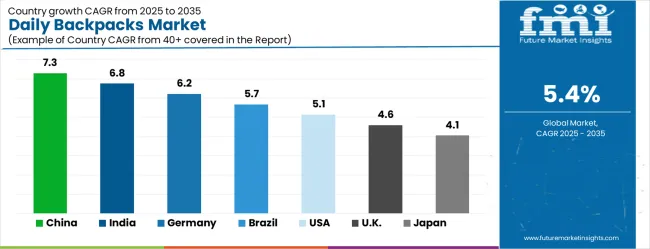
| Country | CAGR (2025-2035) |
|---|---|
| China | 7.3% |
| India | 6.8% |
| Germany | 6.2% |
| Brazil | 5.7% |
| USA | 5.1% |
| United Kingdom | 4.6% |
| Japan | 4.1% |
The daily backpacks market is experiencing strong growth globally, with China leading at a 7.3% CAGR through 2035, driven by the expanding middle-class consumer base, growing investment in outdoor recreation infrastructure, and significant growth in e-commerce retail platforms supporting accessible lifestyle product purchases. India follows at 6.8%, supported by large-scale urbanization, growing disposable income among young consumers, and increasing adoption of Western lifestyle trends and outdoor activities. The USA shows growth at 5.1%, emphasizing premium outdoor gear innovation and active lifestyle culture development. Brazil records 5.7%, focusing on outdoor recreation expansion and growing consumer goods market penetration. Germany demonstrates 6.2% growth, prioritizing quality outdoor equipment and lifestyle products. The United Kingdom exhibits 4.6% growth, with a focus on outdoor lifestyle innovation and premium gear development. Japan shows 4.1% growth, supported by established outdoor culture and sophisticated urban lifestyle requirements.
The report covers an in-depth analysis of 40+ countries, with top-performing countries are highlighted below.
Revenue from daily backpacks in China is projected to exhibit exceptional growth with a CAGR of 7.3% through 2035, driven by expanding urban middle-class consumption and rapidly growing outdoor recreation participation, supported by government tourism infrastructure development and comprehensive lifestyle retail expansion. The country's massive consumer market and increasing investment in outdoor lifestyle activities are creating substantial demand for versatile daily carry solutions. Major retail companies and international outdoor brands are establishing comprehensive distribution capabilities to serve both domestic lifestyle consumption and growing outdoor recreation participation across urban centers.
Revenue from daily backpacks in India is expanding at a CAGR of 6.8%, supported by the country's large-scale urbanization, growing young consumer demographic, and increasing adoption of Western lifestyle trends and outdoor activities focusing on fitness, travel, and professional development. The country's comprehensive urban development and expanding retail infrastructure are driving demand for modern lifestyle product capabilities. International lifestyle brands and domestic retailers are establishing extensive distribution and marketing capabilities to address the growing demand for quality everyday carry solutions and outdoor gear.
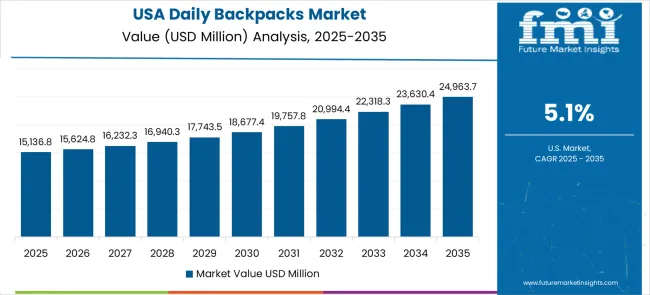
Revenue from daily backpacks in the USA is expanding at a CAGR of 5.1%, supported by the country's established outdoor culture, strong emphasis on active lifestyle innovation, and robust consumer spending on premium lifestyle and recreational products focusing on functionality and brand prestige. The nation's mature outdoor retail market and sophisticated consumer preferences are driving advanced daily backpack adoption throughout major lifestyle and recreational markets. Leading outdoor brands and lifestyle companies are investing extensively in product innovation and comprehensive marketing strategies to serve both domestic active lifestyle consumption and international market leadership.
Revenue from daily backpacks in Brazil is growing at a CAGR of 5.7%, driven by expanding outdoor recreation participation, increasing consumer goods accessibility, and growing investment in lifestyle product retail, focusing on functional everyday carry solutions and recreational equipment. The country's growing outdoor culture and modernization of consumer retail are supporting demand for versatile backpack solutions across major urban and recreational centers. Lifestyle retailers and outdoor equipment distributors are establishing comprehensive market development programs to serve both domestic outdoor recreation and growing consumer lifestyle enhancement.
Revenue from daily backpacks in Germany is expanding at a CAGR of 6.2%, supported by the country's strong outdoor culture, advanced quality manufacturing standards, and strategic focus on eco-friendly lifestyle products requiring environmentally responsible materials and comprehensive functionality integration. Germany's established outdoor industry and emphasis on product quality are driving demand for premium daily backpack solutions focusing on durability, environmental responsibility, and comprehensive feature integration. Outdoor equipment companies are investing in comprehensive green development capabilities to serve both domestic quality-focused consumption and European market leadership with environmentally conscious lifestyle products.
Revenue from daily backpacks in the United Kingdom is growing at a CAGR of 4.6%, driven by the country's innovative outdoor lifestyle sector, comprehensive outdoor culture, and strong emphasis on functional product development focusing on weather resistance, urban-outdoor versatility, and professional lifestyle integration. The UK's established outdoor industry and cultural appreciation for functional design are supporting investment in advanced backpack solutions throughout major outdoor retail and lifestyle centers. Outdoor brands are establishing comprehensive development programs to serve both domestic outdoor lifestyle requirements and international product innovation leadership with versatile carry solutions.
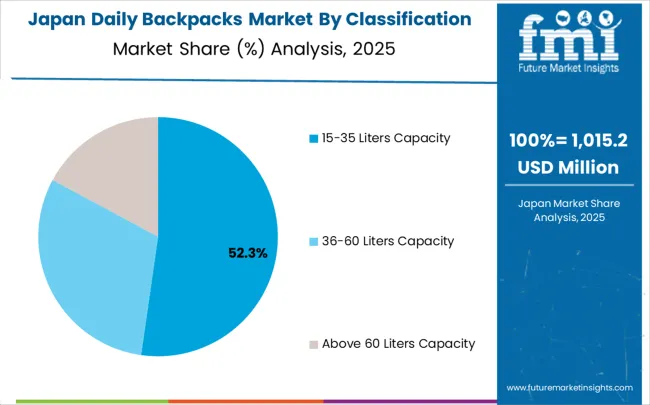
Revenue from daily backpacks in Japan is expanding at a CAGR of 4.1%, supported by the country's sophisticated urban lifestyle culture, established quality product appreciation, and strong focus on functional design requiring precise organization, superior materials, and comprehensive daily functionality integration. Japan's advanced consumer culture and emphasis on product excellence are driving demand for premium daily backpack solutions, including minimalist design, superior craftsmanship, and comprehensive urban lifestyle integration. Leading lifestyle companies are investing in extensive product development to serve domestic quality-focused consumption and international design standard setting with innovative carry solutions.
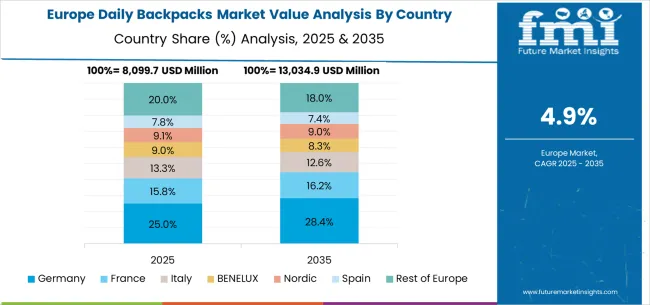
The daily backpacks market in Europe is projected to grow from USD 7,305.6 million in 2025 to USD 12,361.3 million by 2035, registering a CAGR of 5.4% over the forecast period. Germany is expected to maintain its leadership position with a 28.0% market share in 2025, growing to 29.0% by 2035, supported by its strong outdoor culture, advanced eco-friendly product development, and comprehensive quality-focused consumer market serving major European outdoor and lifestyle segments.
The United Kingdom follows with a 22.0% share in 2025, projected to reach 21.5% by 2035, driven by robust outdoor lifestyle innovation, established weather-resistant product development, and strong functional design culture, combined with comprehensive outdoor retail infrastructure and professional lifestyle integration requirements. France holds a 20.0% share in 2025, expected to reach 20.5% by 2035, supported by luxury lifestyle heritage, established outdoor recreation culture, and increasing adoption of premium lifestyle products in urban and recreational markets.
Italy commands a 15.0% share in 2025, projected to reach 15.2% by 2035, while Spain accounts for 8.0% in 2025, expected to reach 8.3% by 2035. The Netherlands maintains a 4.0% share in 2025, growing to 4.2% by 2035. The Rest of Europe region, including Nordic countries, Eastern Europe, Portugal, Belgium, Switzerland, and Austria, is anticipated to maintain a steady presence, expanding its collective share from 3.0% to 3.3% by 2035, attributed to increasing outdoor recreation participation and growing adoption of quality lifestyle products across Eastern European markets, and implementing consumer lifestyle modernization programs.
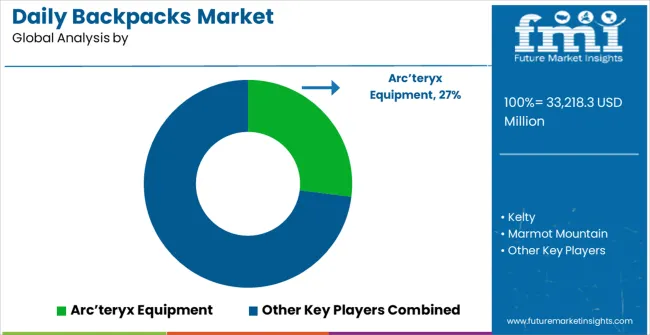
The daily backpacks market is characterized by competition among established outdoor equipment companies, lifestyle brand manufacturers, and specialized backpack producers. Companies are investing in advanced material research, green production development, design innovation, and comprehensive product portfolios to deliver functional, durable, and style-conscious daily backpack solutions. Innovation in eco-friendly materials, smart technology integration, and modular design systems is central to strengthening market position and competitive advantage.
The North Face leads the market with a strong market share, offering comprehensive outdoor equipment solutions with a focus on technical functionality and urban-outdoor versatility. Osprey Packs provides specialized backpack design and manufacturing with an emphasis on ergonomic innovation and comprehensive carrying solutions. Nike delivers extensive athletic lifestyle products with a focus on active lifestyle integration and brand prestige. Adidas offers comprehensive sports lifestyle equipment with emphasis on performance-oriented design and urban functionality. Arc'teryx specializes in premium outdoor equipment, focusing on technical excellence and weather-resistant capabilities. Deuter Sports focuses on specialized backpack manufacturing with emphasis on ergonomic design and outdoor functionality.
| Items | Values |
|---|---|
| Quantitative Units (2025) | USD 33,218.3 million |
| Capacity | 15-35 Liters Capacity, 36-60 Liters Capacity, Above 60 Liters Capacity |
| Application | Men, Women |
| Regions Covered | North America, Europe, Asia Pacific, Latin America, Middle East & Africa |
| Countries Covered | United States, Canada, United Kingdom, Germany, France, China, Japan, India, Brazil, Australia and 40+ countries |
| Key Companies Profiled | The North Face, Osprey Packs, Nike, Adidas, Arc'teryx, and Deuter Sports |
| Additional Attributes | Dollar sales by capacity and application category, regional demand trends, competitive landscape, technological advancements in materials science, sustainable production innovation, smart technology integration, and ergonomic design development |
The global daily backpacks market is estimated to be valued at USD 33,218.3 million in 2025.
The market size for the daily backpacks market is projected to reach USD 56,206.1 million by 2035.
The daily backpacks market is expected to grow at a 5.4% CAGR between 2025 and 2035.
The key product types in daily backpacks market are 15-35 liters capacity, 36-60 liters capacity and above 60 liters capacity.
In terms of application, men segment to command 52.0% share in the daily backpacks market in 2025.






Our Research Products

The "Full Research Suite" delivers actionable market intel, deep dives on markets or technologies, so clients act faster, cut risk, and unlock growth.

The Leaderboard benchmarks and ranks top vendors, classifying them as Established Leaders, Leading Challengers, or Disruptors & Challengers.

Locates where complements amplify value and substitutes erode it, forecasting net impact by horizon

We deliver granular, decision-grade intel: market sizing, 5-year forecasts, pricing, adoption, usage, revenue, and operational KPIs—plus competitor tracking, regulation, and value chains—across 60 countries broadly.

Spot the shifts before they hit your P&L. We track inflection points, adoption curves, pricing moves, and ecosystem plays to show where demand is heading, why it is changing, and what to do next across high-growth markets and disruptive tech

Real-time reads of user behavior. We track shifting priorities, perceptions of today’s and next-gen services, and provider experience, then pace how fast tech moves from trial to adoption, blending buyer, consumer, and channel inputs with social signals (#WhySwitch, #UX).

Partner with our analyst team to build a custom report designed around your business priorities. From analysing market trends to assessing competitors or crafting bespoke datasets, we tailor insights to your needs.
Supplier Intelligence
Discovery & Profiling
Capacity & Footprint
Performance & Risk
Compliance & Governance
Commercial Readiness
Who Supplies Whom
Scorecards & Shortlists
Playbooks & Docs
Category Intelligence
Definition & Scope
Demand & Use Cases
Cost Drivers
Market Structure
Supply Chain Map
Trade & Policy
Operating Norms
Deliverables
Buyer Intelligence
Account Basics
Spend & Scope
Procurement Model
Vendor Requirements
Terms & Policies
Entry Strategy
Pain Points & Triggers
Outputs
Pricing Analysis
Benchmarks
Trends
Should-Cost
Indexation
Landed Cost
Commercial Terms
Deliverables
Brand Analysis
Positioning & Value Prop
Share & Presence
Customer Evidence
Go-to-Market
Digital & Reputation
Compliance & Trust
KPIs & Gaps
Outputs
Full Research Suite comprises of:
Market outlook & trends analysis
Interviews & case studies
Strategic recommendations
Vendor profiles & capabilities analysis
5-year forecasts
8 regions and 60+ country-level data splits
Market segment data splits
12 months of continuous data updates
DELIVERED AS:
PDF EXCEL ONLINE
Daily Cleansing Cream Market Insights – Size, Trends and Forecast 2025-2035
Hiking Backpacks Market Analysis - Trends, Growth & Forecast 2025 to 2035
Bicycle Bags and Backpacks Market - Trends, Growth & Forecast 2025 to 2035

Thank you!
You will receive an email from our Business Development Manager. Please be sure to check your SPAM/JUNK folder too.
Chat With
MaRIA